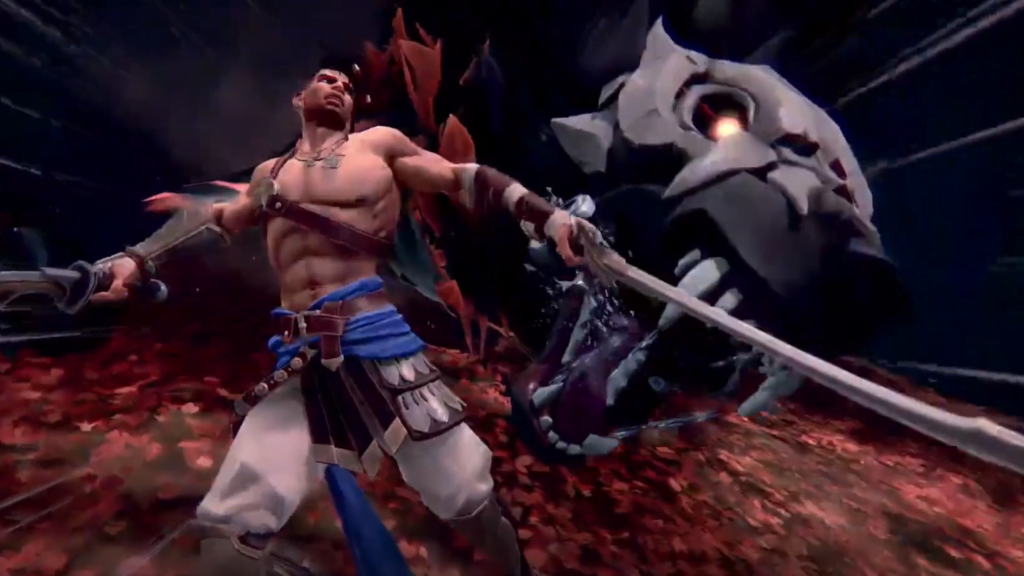
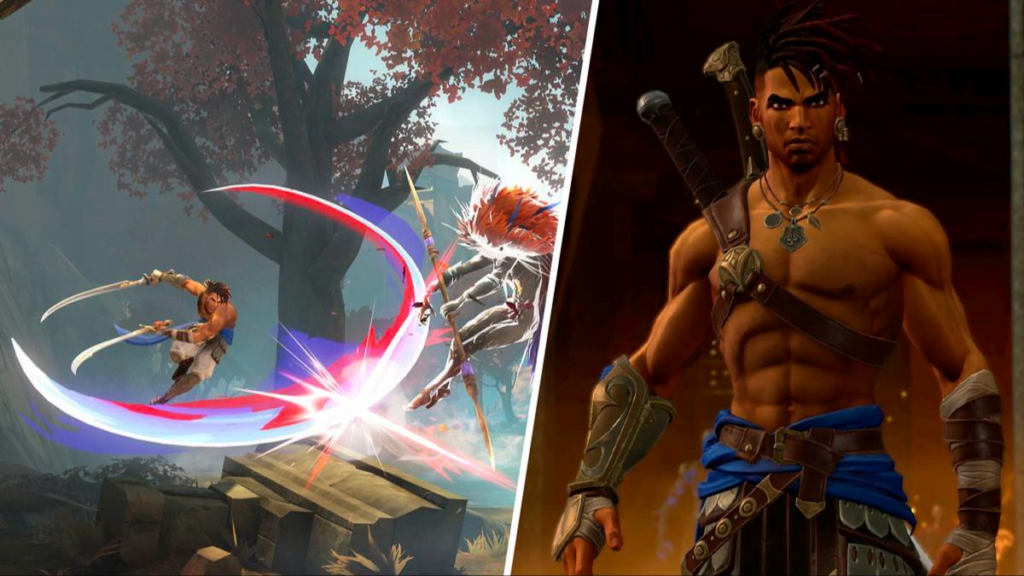
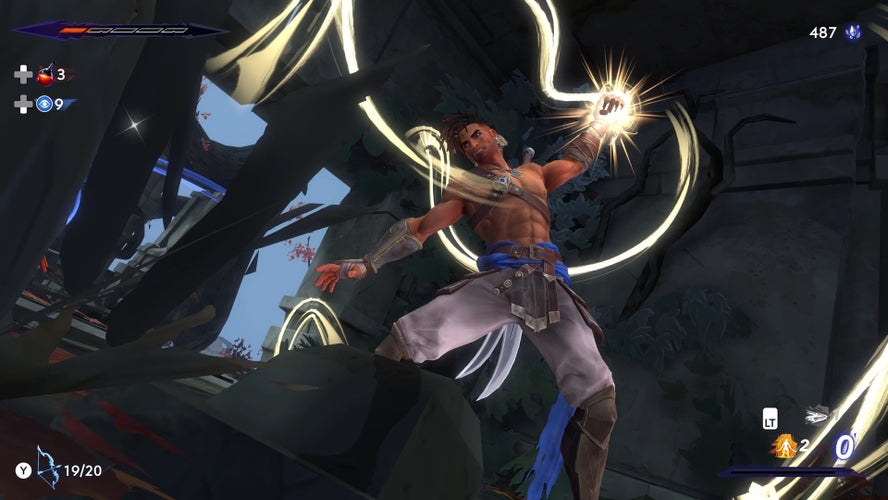
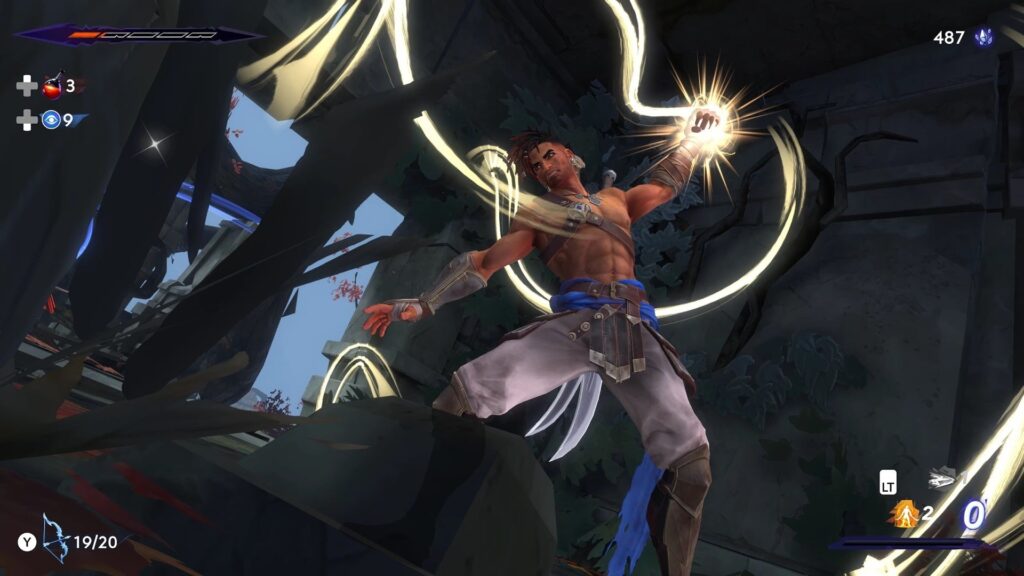
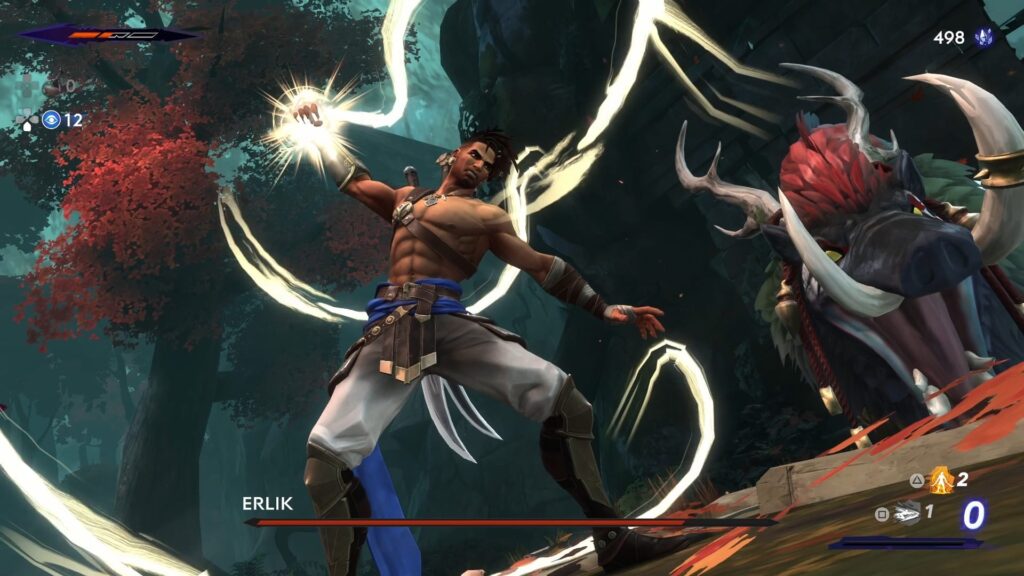
Like The Sands of Time and 2008’s Prince of Persia reboot, The Lost Crown constitutes a reimagining of the series’ concept, striking out in its own direction but maintaining some familiarity. The enticing basics are the same: As a quick, acrobatic protagonist, you explore a massive, semi-ruined location covered in deadly traps and filled with various soldiers and monsters you must overcome with strength and cunning, and time shenanigans are afoot. The similarities end there, though, as The Lost Crown tells a new story based in Persian mythology, leaning into an adventure filled with cool characters that are often pretty interesting, although the plot can get tripped up in its details and delivery as you explore the maze-like map.
At the heart of the tale are the Immortals, a group of seven nearly superheroic warriors, dispatched to the legendary Mount Qaf to rescue the kidnapped prince of Persia, Ghassan. You play as Sargon, the youngest and most brash of the group, whose struggles both with proving his place among the Immortals and with chasing down his mentor, responsible for the kidnapping, make him a compelling character throughout the twisty, though somewhat predictable, journey. Sargon is a fierce, fast warrior, and while this is a Metroidvania and unlocking new abilities over time is an essential element of the formula, he’s a capable fighter from the start. In fact, The Lost Crown’s focus on giving you plenty of tools in combat right away is a huge part of why it works so well. Fighting enemies is as compelling as exploring the sprawling map thanks to combat that emphasizes speed, reaction time, and pressing your advantage.
This combat system often moves at an almost breakneck pace.
This combat system often moves at an almost breakneck pace. Sargon’s speed is his greatest advantage, and even basic enemies hit hard enough that you need to take them seriously. It’s a balance that creates situations where you always need to be reading enemy movements, and your best bet is usually to keep moving and keep attacking. The threat most enemies present kept every battle exciting and important across my 25 hours in Mount Qaf, even on the “normal” difficulty mode, and the fun comes from learning to master everything at your disposal. The Lost Crown sports four difficulty options, as well as the ability to customize things like enemy health and damage and parry window size, and combat is exciting enough that I’m looking forward to starting new runs on the tougher levels to put my skills to the test.
One of The Lost Crown’s best ideas is to increase its focus on melee action beyond what you might expect from a Metroidvania’s combat system — almost Sekiro: Shadows Die Twice meets Devil May Cry. Your goal in fights is to create and maintain combos that can give you an advantage. Kicking smaller enemies into the air allows you to juggle them and keep them from fighting back, while the goal with larger enemies is usually to get behind their defenses to evade their blows while ravaging them with your own. In addition to regular strikes, upward and downward attacks, and aerial maneuvers, Sargon also has moves that chain off dodges and slides, and heavier attacks that can be charged up or change depending on when you execute them in a chain. You wind up with lots of different moves at your disposal that can be linked together in different ways depending on the situation and the enemy you’re fighting. All of Sargon’s attacks are simple and easy to execute, but still made him feel like a fierce warrior at all times, especially as I learned how to read opponents and pull off combos that allowed me to absolutely dominate them.
Adding to the thrill is the fact that combat is so damn stylish. Sargon and the other Immortals who appear as NPCs zip across battlefields at impossible speeds as bright colors splash over the background. You don’t have a proper block, but you can parry some moves, and parrying specific, powerful attacks triggers a quick execution cutscene that eliminates regular enemies outright with flair, rewarding you for understanding your opponent and reacting quickly. Miss a parry, however, and you’re left vulnerable; The Lost Crown will show you just how bad you messed up with a giant splash of red as you take your hit.
Flashy sequences also mark Sargon’s special Athra Surge abilities, which you’ll unlock as you progress through the story and have to be charged up by damaging enemies. But when you jump through those hoops you’ll be able to do things like throw several foes into the air at once, create a healing field, or fire a hugely powerful arrow. They all come with their own cool cutscene animations that emphasize the power you’re unleashing.
Never is combat better than in boss battles, though. All the same rules of regular battles apply, with attacks that can be parried and some that trigger counters to land a huge, cinematic hit. But bosses all have similar tools to your own, like unparryable moves that have to be dodged, and even their own Athra abilities that you have to learn and avoid.
As with combat, platforming is consistently excellent.
One boss trounced me again and again by using a counterattack ability that triggered when I hit him — not only did he turn my attack against me, but I got to be humiliated by a killer cutscene as he buried a kamehameha-like blast of energy in Sargon’s chest. These moments come across like gods clashing as a result, and The Lost Crown’s bosses having abilities similar to yours makes them feel like true contests of skill.
The other half of The Lost Crown is its platforming gauntlet. As with combat, platforming is consistently excellent. In fact, your abilities are often so useful that you can work your way around obstacles with ingenuity rather than by unlocking a particular move. A few times, slipping under a ledge with a dash and linking that into a double jump, or carefully timing wall jumps, got me to places I didn’t initially think I could reach. You can never perform quite so well that you wind up in places before you belong there (though I’m sure speedrunners will find a way to do just that), but there are a few times when being adept in platforming feels extra rewarding as you scale a mountain wall or across a deadly precipice.
Most of the abilities you’ll unlock while making your way through Mount Qaf will be familiar to Metroidvania fans — staples like a double-jump, a mid-air dash, and a grapple. In its platforming, The Lost Crown doesn’t break the mold, but it does execute everything it attempts exceptionally well. Some really great, challenging level design will put you through your paces dodging swinging blades and avoiding spikes, and the obstacles you face never feel cheap or frustrating.
The Lost Crown discards the time-rewinding power that defined most of the Prince of Persia games by allowing you to undo mistakes. Instead, when you fail during a platforming section, you’re just returned to the last chunk of solid ground you touched with a little damage to your health bar. As long as you’re not out of health, you’re free to try again immediately. It isn’t as thematically neat as the rewind feature, but it is functionally a quicker, cleaner approach to allowing you to adjust for your errors. It’s rare that a platforming section feels too long or is annoying to repeat since you can make additional attempts almost instantly, and you only really suffer consequences when you fully run out of health.
Mount Qaf itself is a big map with a lot of impressive areas, each with a different feel and slate of mechanics. Again, the ideas at play here aren’t rewriting the Metroidvania playbook, but they serve very well to provide a lot of variety and interesting obstacles. Each has its own vibes, enemies, and ideas, like an underground pirate harbor filled with explosives and ambushes, and an academy area where keeping quiet is necessary to avoid a towering, overzealous, blind librarian. You’ll revisit each location over and over again as you unlock new abilities that make additional areas accessible, and they’re all different enough that return trips remain interesting even late in the campaign.
The map photo system is something every Metroidvania should emulate.
The Lost Crown also lets you snap a photo of a spot where you see something you can’t currently reach or a puzzle you don’t yet understand, which adds the image to your map. It’s a brilliant system that every Metroidvania should emulate. On more than one occasion, checking over photos I’d taken early on led to “Eureka!” moments — like one in which I realized the solution to a puzzle that involved a crushing wall required placing a statue into the trap. I finally got it only after carefully examining the background of the room, littered with smashed statues, and thanks to the photo marking the spot, it was trivial to quickly return there. The system encourages you to find and solve everything Mount Qaf has to offer, and cuts down on the irritating need to scour an area for something you may have missed.
My favorite location was a sea battle frozen in time, where you can walk on waves mid-crash and see combatants flung by explosive cannon fire arrested in mid-air. As you progress, you eventually restart time for part of the area, forcing you to travel through the stormy battle even as other parts of the location are still frozen, creating a very cool effect. But it was elements like this sea battle that made me wish The Lost Crown leaned harder into its ideas about the broken flow of time, which is more something characters talk about than something that actually happens on screen. People will mention seeing different versions of the Immortals or even claim they’ve interacted with Sargon before you’ve met them, and these are some of The Lost Crown’s most fascinating ideas — but it doesn’t fully explore them.
That was a problem throughout the story, in fact. At points, I felt like I had missed things; after a particularly wonky bit of time-rearranging, Sargon keeps asking characters if they remember meeting him, as if he’d run into someone who had forgotten him because of the altered timeline. But if that person existed, I never found them, and nobody ever acted like time’s shifts had stolen their memory of what I’d experienced.
The same is true of one of The Lost Crown’s side characters, who disappeared at one point never to be seen again, and I had one minor side quest that never seemed to advance correctly. Additionally, the relatively open, interconnected world of Mount Qaf sometimes plays against the story that takes place within it, where taking a certain path can cause you to miss events or reach them slightly out of order, which might have been interesting if this was a deliberate effect of the time-twisting story, but instead just makes things feel a bit jumbled and perplexing.
The Lost Crown leaves parts of its story untold or confusing.
Even after I finished, the whole tale seemed to have a few lingering plot holes. It might be that part of the story is locked behind the biggest and most arduous side quest, or it could be that the many collectible lore items are meant to fill in the gaps. But unless you attempt to get reasonably close to 100-percent completion, The Lost Crown leaves parts of its story untold and, as a result, other parts are confusing. As much as I liked the characters throughout, its conclusion was somewhat unsatisfying due to what seemed like missing pieces.
And while the voice acting for the main cast is strong throughout, there’s one minor character where the quality is noticeably worse. It turns out that’s because this character isn’t voiced by an actor at all, but by a free text-to-speech program you may have already heard reading out Twitch donations at one time or another. Ubisoft has said this was a placeholder left in by mistake, and it expects an update with a human voice to arrive by early next month, but it won’t be in the planned day one patch. The artificial voice isn’t bad enough to actively detract from that section — we’re talking about a character who only has a small handful of voice lines and who you’ll see maybe twice in 20 hours — but it’s still pretty embarrassing.

